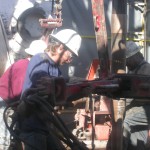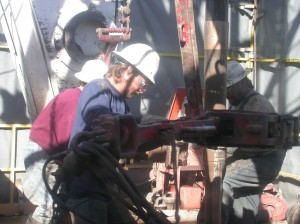
by David Frey | Oct 15, 2003 | Environment, Fuel to the Fire, News

Rig workers make a connection on a Garfield County, Colorado gas rig. David Frey photo.
 Almost 4,000 feet below Hunter Mesa, the earth was churning. A volleyball-sized drill bit studded with diamonds and knobs of tungsten carbide tore through sandstone and shale, steadily working its way to the natural gas below.
Almost 4,000 feet below Hunter Mesa, the earth was churning. A volleyball-sized drill bit studded with diamonds and knobs of tungsten carbide tore through sandstone and shale, steadily working its way to the natural gas below.
From the drilling platform at the foot of a 40-foot derrick, the noise was deafening: the sound of a nation’s energy appetite on the hunt.
Using a four-foot-long pair of metal tongs, roughnecks unhooked the drilling apparatus and added another length of steel pipe.
” They drilled as far as they could,” said Richard Eberspecher, drilling superintendent for the Canadian gas company EnCana, which is leading the charge in gas production among the meadows south of Silt. “Now they have to put another one on.”
It’s called a connection, and it marks the progress toward reaching the gas field beneath the Piceance Basin in 31-foot increments.
Looking at the wells from their homes, many nearby residents see the coming of the energy industry as a blight on the landscape. Looking down from a gas rig, drill crews see the future.
“There isn’t an overabundance of plentiful, easily-accessible natural gas in the United States and they need to drill it. You know?” Eberspecher said. “The more self-sufficient we are, the better off we are, don’t you think?”
As America’s energy appetite grows and its natural gas supplies dwindle, the Rockies hold an ever-growing importance in the nation’s energy strategy. Experts say the region may hold a quarter of the nation’s gas reserves. Garfield County could play a key role. And industry could play a huge rule in Garfield County’s future.

A worker on an Encana rig near Parachute, Colorado. David Frey photo.
‘An enormous steamroller’
“There’s an enormous steamroller poised to come into Garfield County,” said Randy Udall, director of the nonprofit energy organization Center On Resource Efficiency, or CORE, based in Aspen and Carbondale.
Natural gas may be the county’s economic driver for the next 30 or 40 years, Udall said. That could mean big economic impacts, but also major environmental and social impacts, dwarfing the oil shale boom that boosted western Colorado in the early 1980s, then crushed it when it went bust.
“The Colorado Geological Survey estimates that there may be anywhere from $15 billion to $80 billion worth of gas in Garfield County still to be produced,” Udall said. “Natural gas is going to be much bigger than oil shale ever dreamt of being, and I think people are just beginning now to understand that. It’s going to be much bigger than the ski business. It’s going to be much bigger than the recreation industry.
“Garfield County has historically been kind of the poor cousin to the richer mountain communities that have been based on tourism. But in the decades to come, I think gas development in Garfield County is going to eclipse the economic punch of the higher mountain towns like Aspen and Vail and Summit County.”
County officials say they’ve already seen the impacts. While other resort communities have suffered in the economic downturn, they say Garfield has weathered it better.
“The gas industry has got to be one of the most positive and bullish parts of the Garfield County economy over the coming decades,” Udall said.
EnCana has just eight staffers at its Rifle headquarters, but last year tallied some 526 contractors, most staying a few weeks or months before moving on. Williams Production has over 50 employees and more than 400 contractors.
Those numbers are likely to grow over the coming years, and shift toward more fulltime employees. That could also mean a shift toward more local workers. Colorado Mountain College started offering classes in gas technologies to train a local workforce. And it could mean more itinerant workers settling here for ongoing jobs.
“Five years from now, I would say we’re going to more than double the number of people,” said Steve Soychak, Williams’ district manager at Parachute. “Ten years from now, it’s hard for me to say. Maybe double more, I don’t know. It could be big.”
For those wary that any energy boom may be followed by a bust, this one could have some advantages. Because so many workers are from out-of-state, a bust wouldn’t mean the huge loss of local jobs that followed the oil shale bust. And because the wells will pump for decades after the drilling stops, tax revenues should keep flowing.
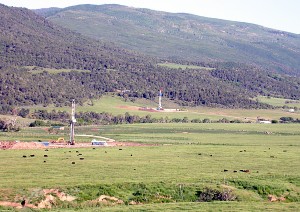
Gas rigs dot the western Colorado landscape. David Frey photo.
Decades of dependency
It’s a mixed blessing, Udall said, that could bring wealth at the cost of Garfield County’s character.
“That very rural landscape right now is going to end up having many thousands of gas wells drilled inside of it,” he said. “It’s going to gradually morph from a rural ranching landscape into an industrial landscape that’s primarily dedicated to gas development. There’ll still be some ranching. There’ll still be some farming going on there, but the bulk of the economic activity is going to be gas production.”
Industry representatives say it won’t be that severe.
“One thing people tend to overlook is that residential growth is much more disruptive to wildlife habitat than oil and gas drilling in terms of homes, rooftops, roads, dogs, cats and all of the traffic that’s involved in that,” said Ken Wonstolen, senior vice president and general counsel for the Colorado Oil & Gas Association.
Many observers agree the search for natural gas in the Rockies will likely play out over decades and become more and more critical. Natural gas demand is growing, fueled, ironically, by environmental concerns that saw coal-fired power plants replaced with gas-fired generators.
The U.S. Energy Information Administration predicts gas-powered energy plants will double their use by 2025, accounting for a third of the gas that’s used. Meanwhile, as traditional domestic supplies trail off, gas pumped from the Rockies is predicted to see the biggest boost. Imports from Canada and elsewhere are also expected to gain. (Already, the U.S. consumes half of the gas produced in Canada.) Shipping it from elsewhere is costly and hazardous – it must be cooled to 260 degrees below zero before it can be safely transported.
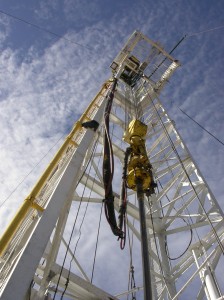
A gas rig rising over Garfield County. David Frey photo.
As demand increases, prices will likely go up, too, making the gas in the West that much more valuable.
“I think sometimes we see kind of a false dichotomy set up, sometimes by the media and by opponents of oil and gas, who say it’s industry profits versus the environment,” said COGA’s Wonstolen.
“The reason there are profits to be made is that there’s a demand for that energy from the citizens of the United States. So it really is, are we going to have the energy for our lifestyle and our economy and the health of our nation or not? If we’re not going to do it here in the States, we’re going to develop it other places where it may or may not be secure. We’re going to bring it across the ocean with the attendant potential disasters that we know could happen there. These are just the choices that have to be made and they ought to be made in an informed way.”
Alternative fuels could lessen our dependency, but even those who eye hydrogen fuel cells as an upcoming power supply expect to initially use natural gas as the source of hydrogen.
Some call natural gas a “bridge fuel,” Wonstolen said.
“We don’t know what the answers will be, he said, “but we have decades ahead of us where natural gas will be of increasing importance, both here and internationally, as the preferred energy source, because of its clean-burning qualities.”
Seven generations
That worries some observers, who fear the nation’s appetite could outpace production, and threaten sensitive areas.
“In the long run, the nation faces a really chronic gas crisis,” Udall said. “During our history, we’ve used more gas than all the rest of the world’s citizens combined. According to some experts, half of all the gas that will ever be produced in North America has already been burned. It’s not that we’re running out of gas, but that gas is getting more difficult to find.”
The cost could be highest on public lands. Environmentalists criticize the Bush administration for pushing to open these areas to drilling without proper environmental protections. That concerns Mike Dombeck, who served as BLM and Forest Service chief in the Clinton administration.
“We’re looking at the need to road unroaded areas, the need to risk water quality, the need to degrade fish and wildlife habitat, recreation opportunities for the future,” Dombeck said. “We’ve gotta face it. The easy stuff is gone. As we’re assessing whether or not we need to get into these areas, we need to take a long-term look and ask ourselves the question, based on the Native American saying, we should be making decisions for seven generations. I don’t think the oil and gas development that we see on the remaining public land passes that test. Only in very rare cases, perhaps.”
For Udall, that means a need for a greater more renewable resources, like wind and solar power. It also means better efficiency in things like furnaces, insulation and air conditioning. Even many industry representatives say conservation will have to play a bigger role in our energy policy. Most home furnaces waste about half the gas they use, Udall said. The Air Condition Contractors of America estimate up to 30 percent of energy used for cooling is lost through poor design and insulation. And heated driveways?
“Is this the best use of a very valuable resource?” Udall asked. “Some people would say no.”
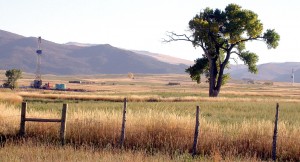
Gas wells are becoming a fixture in some rural Colorado landscapes. David Frey photo.
Bridling the dragon
Since gas will likely be a big player in Garfield County for decades to come, Udall said, there’s time for caution, and a need for stiffer regulations to protect homes and the environment, while still reaching the gas.
“The gas industry is like a big dragon, and in my view, we’ve got to bridle this dragon. We’ve got to hobble it and we’ve got to do gas development right. … I think local government and local citizens need to organize to minimize the negative impacts and maximize the positive impacts of gas drilling in Garfield County.”
Industry representatives say they’ve come a long way in using measures that better protect the environment in what is by its nature a destructive activity.
“We’re doing as good as we can and still harvesting the gas,” said Encana’s Eberspecher.
But critics complain the federal government is lessening regulations to make drilling easier, state regulators put a higher priority on profits than protection and local governments have little control.
Steve Smith, a coordinator with Western Colorado Congress working with local landowners to address drilling in their backyard, said Americans should learn from past blitzes for timber and coal that left the landscape scarred.
“Yeah, this may be the current pocket of gas, ‘and the nation needs gas,’ but we’re not going to do it the way we did the timber and coal in Tennessee and Kentucky,” he said. “We’re going do it selectively. We’re going extract it in a way that still respects people’s lives and preserves the natural environment and keeps intact the scenic beauty that is the reason we’re all here anyway.”
That’s the hope of many landowners who have found themselves neighbors to gas wells. Eleven miles south of Silt, homeowner Peggy Utesch drove past hay fields she feared will soon be gas fields. She’s fought the industry, she said, because she’s afraid without taking a stand, landowners will get run over.
Motoring along dirt roads that cut through green pastures dotted with derricks, she stopped at an old schoolhouse and church. Across the road, an orange streamer fluttered from a stake alongside a barbed-wire fence.
Utesch said she cringes when a new orange flag appears; they mark spots for new wells, like this one, in a horse pasture.
“You look at the size of the destruction and you can just imagine this whole area, this bucolic green ranchland out here, just dotted with these (wells),” she said.
A few months later, a drilling rig rose from the horse pasture, and the roads winding south of Silt were dotted with more orange flags.
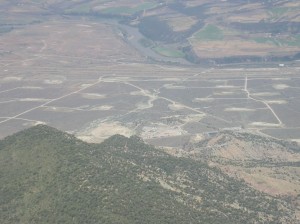
by David Frey | Oct 14, 2003 | Environment, Fuel to the Fire, News, The West

Western Colorado gas drilling creates a network of roads and well pads throughout rural areas. David Frey photo.
 As Garfield County sees its landscape transformed by the gas industry, local officials are left with little control, with the state claiming authority over the industry.
As Garfield County sees its landscape transformed by the gas industry, local officials are left with little control, with the state claiming authority over the industry.
But a recent state Supreme Court ruling suggests that the county may have more authority than was ever believed.
As Garfield County embarks on an overhaul of its land-use codes, some residents are asking it to play a bigger role in enforcing gas regulation.
“We believe the county can do more than it has been doing, even under state law,” said Steve Smith, a coordinator with the activist group Western Colorado Congress. “We believe state law should be altered so they can do even more beyond that.”
Residents are asking commissioners to take steps that are beyond their control, said County Commissioner John Martin, a Republican. The regulatory Colorado Oil and Gas Conservation Commission has been given the authority to oversee the gas industry, he said, and local governments can’t use their ordinances to regulate them.
“You can rewrite them,” Martin said. “Are they enforceable? No. If there’s any kind of conflict between (state) oil and gas rules and regulations and Garfield County regulations, the state of Colorado reigns supreme. They override any kind of regulation that you think you would want to put on if they find it detrimental. So if it’s detrimental to the industry, they’re going to override it, and your rules and regulations are unenforceable.”
On one battle the county took to the courts over gas drilling on private land, commissioners filed 63 complaints, from well location to density to air and water quality. Only three issues were ruled in its favor.
The county could draft stiffer regulations, Martin said, but it wouldn’t be able to defend them in court.
“We can spend the county’s money doing that, and that will satisfy some people that we are fighting,” he said. “But it may upset a lot more people, knowing that we are trying also to waste their money, knowing that we will never succeed.”
Tough regulations
But one county is having success. Southwestern Colorado’s La Plata County has long been an energy-industry hotspot. After concerns from landowners, the county put in place in the late 1990s what are considered the toughest county regulations on the energy industry.
“The commissioners were really supportive of trying to get these through,” said Steve Clay, a La Plata County planner who oversees oil and gas issues. “They were willing to be sued. They knew they were going to be sued over this. … If you try to get into a situation where you want to create regulations saying ‘try not to do anything that’s going to (provoke) a lawsuit,’ you’re not going to be able to get too far.”
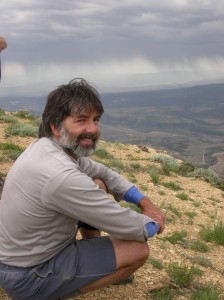
Steve Smith atop the Roan Plateau. David Frey photo.
The regulations have largely worked because energy companies have been willing to cooperate, Clay said. They were put in place only after long negotiations with operators over what rules they would and wouldn’t tolerate.
They did get sued. One key issue – control over noise levels – was struck down. Others lawsuits are still being fought. But one issue has been decided in their favor.
When a court ruled against the town of Frederick’s attempt to enforce regulations against industry in heavily-drilled Weld County, La Plata County appealed, arguing local governments should have the same land-use control over the gas industry as it has over any other.
The state Supreme Court ruled 2-1 in its favor in September, giving La Plata County the confidence to keep its rules in place, at least for now.
Some industry critics say Garfield County should do the same.
“Garfield County is deeply in the energy business. We can’t ignore it,” said Sue Daley, a former Breckenridge resident who settled with her husband in a log-kit home on a 100-acre ranch south of Silt. “For the county to turn their back on including it in their development code is just nonsensical.”
Commissioner Trési Houpt, a Democrat, agrees. She said the county should at least put in place regulations over issues like safety that it knows it can control. It might be worth risking a lawsuit to put in place even tougher regulations, she said.
“I think it’s always worth pushing the envelope when you believe something’s worth protecting,” she said. “I believe our environment’s worth protecting. I believe wildlife is worth protecting. I believe people’s quality of life and businesses are worth protecting.”
More control

Gas wells and haystacks share the western Colorado landscape. David Frey photo.
Meanwhile, many agree that the state legislature should hand over more authority to local counties.
“I think it has to because it happens to be a land-use issue, and because we are being encroached upon – what we perceive as encroaching,” Martin said.
“It’s unpleasant. It’s noise. It’s smelly. It disturbs our peace and quiet. I mean, it changes our lifestyle. It’s going to have to change a little bit. But that’s gonna be up to a lot of hard work for the counties and the citizens, working with the oil and gas commission and the industry to get those things changed. It’s not going to be a panacea by passing some rules that are unenforceable. We’re going to have to come to a compromise with the industry and an acceptance from both sides, citizens and industry, saying we can live with these.”
Outgoing Rep. Gregg Rippy said standards may need to change, but it should happen statewide, not county by county.
“Just because you’ve got a county line there doesn’t mean that somebody across that line may not be impacted,” the Glenwood Springs Republican said.
That may mean changing the charge of the COGCC to have a stronger role in regulating surface impacts, he said.
Opponents want to change far more. By statute, five of the seven COGCC commissioners must have industry ties. Currently, they all do. Supporters say that’s needed because of the technical issues it sorts through. But opponents say that leaves the commission like a fox guarding the hen house.
In 1994, the commission’s role was expanded to protect the health, safety and welfare of landowners, but critics say too often it leans in favor of the industry and protecting profits.
“I think it is absolutely essential that we change the composition of the commission members,” said the WCC’s Smith.
Rippy backed a failed bill to give surface owners an extra representative on the commission. That met opposition from both industry and environmentalists who said it didn’t go far enough, he said. His predecessor, Russell George, of Rifle, pushed a bill to make the majority non-industry. It failed by one vote.
Industry representatives aren’t anxious for more regulation.
“If you allow the counties to start doing special permits for every well, for instance, and hold public hearings for every well, it would be very difficult to drill wells here,” said Steve Soychak, district manager at Parachute for Williams Production, a Tulsa, Okla.-based energy company.
“What’s that going to do for the supply outlook? I like the fact that it’s regulated by the state. Sometimes, I wonder if it shouldn’t be regulated by the nation, because it is an important energy supply. I realize it does impact the neighbors and we have to work with them and be good neighbors. I think the rules are pretty good right now with the Oil and Gas Conservation Commission.”
In La Plata County, Clay says, regulations have helped smooth over differences. After watching Garfield County landowners snap at industry representatives and storm away from a recent public meeting in Rifle, he said Garfield County’s squabbles look like La Plata looked a few years ago. Since then, he said, the animosity has cooled considerably.
“There is a way out of it,” he said. “They say there’s an informed consensus. That doesn’t mean everybody’s going to agree with what you’re trying to achieve, but everybody has to know that the county has to be able to regulate land use. The industry needs to be able to extract the minerals. The property owners need to be able to protect their property rights. There’s absolutely no way to have all three of them get exactly what they want.”

by David Frey | Oct 13, 2003 | Environment, Fuel to the Fire, News, The West

Gas wells and haystack share the landscape in rural Garfield County. David Frey photo.
 From the top of Grass Mesa, it’s hard to feel much threat from the gas development spreading across the lands below.
From the top of Grass Mesa, it’s hard to feel much threat from the gas development spreading across the lands below.
Garland Anderson’s modest one-story home commands a grandiose view of the Colorado River Valley, from the Grand Hogback cutting a jagged ridge to the east to the Roan Plateau’s sheer bluffs to the west.
But like his neighbors, Anderson knows if drilling rigs haven’t yet reached his home, an 80-acre mesa-top spread he shares with his wife Diana, plus six goats, three horses, 10 cats and two dogs, it’s likely just a matter of time.
The sagebrush, hayfields and rocky ridges that spread south of Silt and Rifle lie on top of the Mamm Creek field, believed to be one of the richest sources of natural gas in the Piceance Basin, and Grass Mesa has seen some of the densest gas development.
That’s made the Andersons, like many neighbors, unwitting activists against the gas industry. Their main battle is with EnCana, the Canadian gas exploration giant that has bought up gas leases throughout the region and launched a dramatic push to extract the natural gas known to lie underneath the scattered homes and ranches.
Landowners have complained that the increased activity has wreaked havoc on the rural area: New roads have scarred the landscape; equipment and traffic has created noise and pollution; wildlife has been scared away; massive compressor stations have been built to keep the wells pumping.
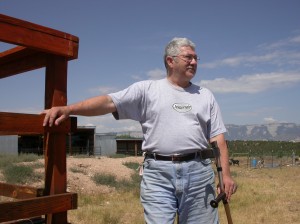
Garland Anderson stands at his Grass Valley home, which sits amid a growing number of gas wells. David Frey photo.
They fear the drilling could damage or decrease their well water, and the industrial activity will harm their property values.
“The only thing that has worked has been to push them to the limit and take it all the way to finally get an attorney to talk to their attorney and they realize that we’re not going to be railroaded and walked on,” Anderson said, “that we are going to defend our rights. We have never asked for anything other than our rights.
“All we want is respect of our property, and them to do the least amount of damage as possible to our properties and to give us some consideration, just as human beings. That’s what we’ve asked for. But it’s been difficult in coming.”
In recent months, the company has become more cooperative, Anderson said, but that’s come only after vigilance by locals.
“They know that until someone slaps their hand, they’re going to do what they can to make that dollar,” he said. “That’s understandable. That’s the American Way. I’m not knocking making the dollar. But we are a lot upset that it is a Canadian company that is doing things here in America that they can’t do at home. … They’re coming down here and destroying our property and sending the money back home.”
Anderson is an unlikely candidate to take on the industry. Before retiring to Colorado, he spent 20 years traveling the globe performing seismic work for major oil companies preparing offshore rigs.
Now, he’s a member of the Grand Valley Citizens Alliance, a group of western Garfield County residents opposing gas development in their backyard, and Western Colorado Congress, a Western Slope activist group working with them.
“Believe me, I never thought about it,” he said. “I was working for the money. That’s what I suspect is going on up here.”

Gas wells are becoming a fixture in some rural Colorado landscapes. David Frey photo.
Split estate
At the heart of landowners’ complaints lies the “split estate,” which divides surface rights from mineral rights. As properties are sold and resold, the owners of the land and the minerals are often different. Mineral rights owners may lease their holdings to energy companies, and energy companies have the right to extract them.
Those who don’t own the mineral rights may find energy companies at their doorsteps. They can work out some agreements as to where they can drill, how they should reclaim the land and how much compensation they can get, but their rights are limited, and they can’t turn them away.
Anderson admits he saw gas development below when he bought his home, but he said he and others were led to believe it would never come up the mesa. That’s changed. He’s as critical of EnCana as he is of the former Aspen developer who sold the land, he said, knowing what was coming. The developer now lives in Carefree, Ariz., Anderson said ironically, mineral rights in hand.
“I would say, in my opinion, we were duped,” he said.
Conflicts over severed mineral rights make up the bulk of complaints to the state regulatory agency, the Colorado Oil and Gas Conservation Commission, even though the commission says it has no authority to address them.
“Landowners either don’t accept, don’t understand or don’t want to accept that they don’t own the mineral rights, and they’re property rights that somebody else has the right to access,” said Rich Griebling, the commission’s director.
As a question of property rights, he said, the government can’t stand in the way.
Mineral rights have long been considered legally superior to surface rights in Colorado, giving landowners little recourse if they felt energy companies were trampling them. That changed this year, when the state Supreme Court ruled the two were equal, but what difference that may mean for landowners remains to be seen. Griebling said his commission has seen no change as a result.
“They’re going to interfere with the surface use just to get to their extraction right,” said Garfield County Commissioner John Martin. “If that’s equal, I guess that’s equal.”
Limiting impacts

Richard Eberspecher, drilling superintendent for EnCana, stands at a rig near Rifle, Colo. David Frey photo.
Industry officials say they’re using state-of-the-art techniques to limit impacts.
“I think we’re trying,” said Richard Eberspecher, drilling superintendent at EnCana’s Rifle office. “It’s still, you’ve gotta drill a hole in the ground.”
He points to a pair of pads next to each other in Hunter Mesa, not far from Grass Mesa. They’re big pads – about six acres altogether, but they have four wells on each, maybe 15 feet apart, instead of drilling four separate wells with four pads. They’re using direction drilling – drilling at an angle underground to reach a wider area instead of drilling straight down from separate spots.
“This looks pretty scarred up now, but it won’t look as bad as you think,” Eberspecher said. “It’s a big development. There’s no getting around that. But they’re doing it as good as they can.”
Dave Grisso, operations supervisor at EnCana’s office in Rifle, said the company uses telemetry to monitor activities from the office instead of increasing truck traffic. Gas byproducts once burned off through flaring can now be “flowed back,” captured and sold. A new water treatment plant lets the company reuse 70 percent of what it extracts.
Such advances have limited the impacts, Griebling said. While drilling across the state has been on a rapid rise, he said, complaints haven’t kept pace. The state has let wells be drilled more densely than anywhere else in the country. But in practice, he said, they’re less dense than ever on the surface because of directional drilling.
“What we’ve seen in this decade is industry on its own initiative going beyond the regulatory requirements and reducing impacts on their own,” he said.
On a tour of EnCana’s operations, Grisso pointed to wells that had been reclaimed, leaving only a small cap and vegetation hard to distinguish from the surrounding area. The only weeds are in the adjacent ranchland, he noted.
“It’s beautiful up there,” Grisso said, pointing to Uncle Bob Mountain towering above the mammoth Pumba compressor station in the Mamm Creek area. The mountain is home to what’s considered the highest-altitude gas well in the country, at 10,300 feet. The station is a clutch of rigs, metal buildings and industrial boxes on a dirt pad surrounded by green.
“As an oil and gas person, when you look out over all this and you see a beautiful area, is that like a blight to you?” a reporter asked.
“Development can be done responsibly,” Grisso said. “That’s why you have pad drilling. That’s why you take great efforts for your reclamation. That is a beautiful area.”
Fighting the fight
Opponents say they don’t expect to stop gas development, but they want to make sure energy companies are as gentle as possible.
“It’s so inappropriate for them to be drilling in a rural residential and agricultural area,” said Peggy Utesch, who with her husband Bob moved from Glenwood Springs to four acres south of Silt three years ago.
The Utesches say they knew gas development was on the rise when they moved, but then it was concentrated around Parachute and Rulison. Now it’s beginning to surround them. They don’t own their mineral rights, but they say they doubt a well will appear on their land. But they can’t stop them from coming up around them.
It’s changed the landscape and threatened their environment, Peggy Utesch said, and for ranchers, it could threaten their livelihood.
Getting behind the wheel of her Toyota 4Runner, she pointed to ranches that have become drilling sites.
“It doesn’t look like the bucolic ranchland we just drove through,” she said. “It looks like an industrial site of compressor stations, clusters of gas wells sitting on the surface, roads and large well pads and disturbed soils.”
The couple has become active in fighting the development. It’s not a battle they can win, they say, but they may be able to trim their losses.
“I think if we do nothing, we’ll get run over,” Utesch said. “I think if we fight the fight, it will make it a lot better for people in the long run. We’re not gonna stop development, and that’s certainly not the goal. But we’ve gotta keep them from doing it the bad way. If we don’t fight the fight, they won’t do it the right way.”

by David Frey | Oct 12, 2003 | Environment, Fuel to the Fire, News, The West

A gas rig rising over Garfield County. David Frey photo.
Six miles down winding roads that carve through
the mesas south of Silt, the sound of gas flaring is a quiet whisper. Distant derricks jut above the ridgeline, and flames from gas flares flicker over the piñon- and juniper-spotted hills that ring an expanse of green meadows.
Three years ago, Peggy and Bob Utesch moved here from a Glenwood Springs subdivision in search of a piece of Colorado’s fast-disappearing rural heaven. As they listen to the whisper of wells flaring they’re waiting for the whisper to build to a roar, as Garfield County’s boom in natural-gas production creeps eastward, over the humpback ridges, sagebrush meadows and dry arroyos, to engulf them. A new well sits on their neighbor’s property. More are on the way.
This western Colorado big-sky country has long been ranchland. In recent years it’s become home to urban refugees and retirees. Now, it’s the target of energy companies in search of what is believed to be one of the nation’s richest reserves of natural gas as the Rockies become central to the country’s energy future.
“When we came out here three years ago, we could not see any gas wells to the west of us at all,” said Peggy Utesch, in an interview last summer. “We read about it in the paper, we knew it was an issue around Rulison and Parachute. We had no idea that it was moving this way. Right now, we can stand on our deck and count 15 wells and probably another half a dozen flares over on Mamm Creek. That is what’s moving this way and what we’re trying to keep from happening.”
This is where the nation’s energy policy – and what some fear is a looming energy crisis – literally hits the ground, on thousands of properties and public lands across central and western Garfield County.
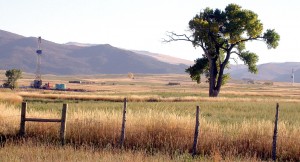
Gas rigs form part of the Garfield County landscape. David Frey photo.
The county has a greater density of wells than anywhere in the country, and the most active drilling rigs in Colorado. Some 300 wells have been drilled this year. Over 1,400 are already in place, producing 350 million cubic feet a day – enough to fuel three homes for a year. The county expects to see 500 drilling applications this year, and thousands more in years to come.
This may be the beginning of a century of gas extraction for Garfield County, said Rich Griebling, director of the Colorado Oil and Gas Conservation Commission. It will likely last at least several decades.
Garfield County has become the third biggest gas producer in a state likewise seeing record wells this year. Its two biggest players are Williams Production, based in Tulsa, Okla., with wells mostly around Parachute and Rulison, and the Canadian gas giant EnCana, which is spearheading a massive project in the more populated area south of Silt and Rifle.
If Garfield follows the lead of Weld, the state’s most-drilled county, that could mean 10,000 wells over the coming decades, said Ken Wonstolen, senior vice president and general counsel for the Colorado Oil & Gas Association, an industry group.
“Just to keep that in perspective,” he said, “10,000 wells in Weld County are more than exist in Saudi Arabia and Iran combined.”
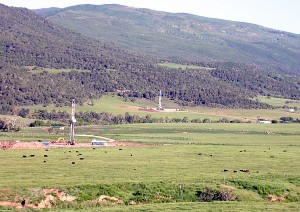
Gas rigs rise south of the town of Silt, Colorado. David Frey photo.
Garfield County residents have found themselves caught in the midst of the West’s latest boom. It’s made unlikely allies among some environmentalists, ranchers and homeowners, pitting them against the gas industry as drilling rigs and pipelines have become common sights in back yards, pastures and federal lands.
Last spring, pirate flags that topped many EnCana rigs came down when neighbors complained their presence only added to a sense of invasion. Industry representatives say the development is needed to keep pace with unslacking energy needs.
“Even though we get a bad rap from a lot of these obstructionist groups,” said Steve Soychak, district manager at Parachute for Williams, “it seems like many of these people (working on the gas rigs) are proud to be producing a clean-burning fossil fuel and providing energy for the country.”
Industry eyes Garfield County
From the windswept mesas south of Silt to the high desert plains around Grand Junction lies Piceance (pronounced PEE-awnce) Basin, 6,000 square miles bordered by the jagged Grand Hogback, near New Castle, and the Douglas Creek Arch, on the county’s western edge. Some 6,000 to 10,000 feet below runs the Williams Fork formation, a strip of tightly packed sandstone laden with pockets of natural gas, long considered rich but unreachable. Four big hot spots lie near Parachute and Rulison, and in the Mamm Creek field south of Silt and Rifle.
One hundred million years ago, this arid landscape was the shore of a swampy inland sea that stretched to the middle of the continent. The dead organic material that washed up here, under pressure for millions of years, became coal. Heated under pressure, it gave off gases, like methane. Gases that remained in the coal kill canaries and coal miners, ignite underground fires and are gathered as coalbed methane. Other gases percolated into underground pockets. That’s the natural gas most energy companies collect in the Piceance Basin today.
“It’s one of the more significant plays in the country,” said COGA’s Wonstolen. “I think the national leadership is looking at the Piceance and other basins like it in the country to be increasingly sources of supply in the U.S.”
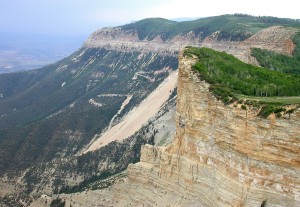
The Roan Plateau rises over the heart of the gas-rich Piceance Basin. David Frey photo.
The Colorado Geological Survey estimates the field may hold 311 trillion cubic feet of natural gas. That would be enough to fuel the United States’ natural gas needs for the next decade. The area between Silt and Parachute could hold a third of that.
But only a fraction may ever be economical to pull out. Ron Johnson, a geologist with the U.S. Geological Survey, said the actual yield may be only 5 or 10 trillion cubic feet.
“That’s a six-month supply,” he said. “That’s not an enormous amount in the grand scheme of things, but when you look at each basin and kind of add them together, it adds up to quite a bit.”
Industry groups say it could yield more than that.
“It’s always been known that there’s a lot of natural gas in place,” Griebling said. “About a hundred (billion cubic feet) per square mile. The challenge has always been, how do you get that gas out?”
The first well dates back to 1955. Since then, technological advances have made natural gas easier to extract, including improvements in fracturing the rock by forcing in water or chemicals. Rising gas prices have made extraction more cost-effective. And dwindling reserves in standbys like Texas and Oklahoma are drying up, making the West’s long-overlooked supplies critical.
Each well can cost energy companies more than $1 million, but they can yield five times that in gas revenues.
“You combine … increasing demand leading to higher prices, better technology and a gas-rich area,” Wonstolen said, “and it all comes together to make this one of the big plays going on in the West.”
Randy Udall, director of the nonprofit Center on Resource Efficiency, based in Aspen and Carbondale, says the pressure is high on up-and-coming producers like Colorado. In the next three years, he said, more than half the gas we use will have to come from new wells as old wells run dry.

Well pads and roads spread out across rural Colorado below the Roan Plateau. David Frey photo.
“This is the nation’s gas appetite that’s landed in Garfield County,” he said.
That’s put landowners on a collision course with energy interests, as ranchers find rigs and pipelines disturbing pastures and fence lines, and homeowners find drilling rigs the very opposite of the quiet, pastoral beauty they moved to the country to find.
“There are a lot of dream homes that are no longer dream homes for people because they’re dealing with drilling right now,” said Garfield County Commissioner Trési Houpt. “That’s the reality of that area.”
‘A subdivision from hell’
Opponents complain about the scarring of the landscape to make room for well pads, and the network of roads cut to access them. Once-quiet lanes fill with workers and trucks. Pipelines cut across pastures. Nonstop drill rigs make noise while they dig, and compressor stations that keep wells pumping never go away.
“When you look down on these gas fields from the air, they sort of look like a subdivision from hell,” Udall said.
Residents worry about chemicals, odors and the danger of leaks. They worry their water supplies could become polluted or run dry. And they say wildlife is chased away. For ranchers, a poorly placed well can harm their operations and a broken fence can be a nightmare.
The drilling is over in about five months. The wells, much less conspicuous than big drill rigs, will produce gas for 30 or 40 years.
“There are a lot of impacts that I think are going to fundamentally change the nature of that landscape,” Udall said.
Industry representatives say those fears are overblown. Once revegetated, they say, well pads are hard to find. Water is protected by well linings and tight rock layers that don’t let the gas filter into water supplies. EnCana recently completed air-quality tests that found evidence of seven of 61 chemicals tested for, and no health risks.
Environmentalists also worry about federal lands they say are endangered by many of the same impacts. Most attention has been paid to the Roan Plateau, a vast mesa northwest of Rifle. But it’s just one of many areas in Garfield County and across the West where public lands – mostly Bureau of Land Management lands – are being targeted by energy interests.
‘Windfall’
In the midst of the development, Garfield County has seen a financial windfall. The gas industry accounts for about a quarter of the county’s revenues. In 2002, it gave the county $12.8 million. Add to that another $364,000 in money turned over from the state in severance taxes and from the federal government in federal mineral leases, plus royalties collected from gas pumped from county-owned land. Last year, Williams was the county’s largest single taxpayer.
The industry also provides jobs, far better paying than the service industry. The average salary runs between $45,000 and $50,000, nearly twice Garfield County’s average wage.
“A lot of these kids were going to Aspen and commuting that far in the construction boom,” said Williams’ Soychak. “Now they can work for as much money or more in the local area and not have to drive as far.”
Most, though, come from places like Wyoming and Utah, contractors who follow the rigs across the West. They work a week, then go home for a week.

Encana's Richard Eberspecher stands below a Garfield County gas rig. David Frey photo.
Boosters say the benefits cross over to area businesses.
“I defy you to go into a restaurant in Rifle or Silt and not find someone in there working for EnCana,” said Richard Eberspecher, that company’s drilling superintendent in Rifle. “You try getting a motel room.”
Last year, Garfield County received severance taxes from the state based on nearly 500 people working in the county in the gas industry. Those numbers are likely to grow.
“Natural gas is going to be the leading economic driver in Garfield County over the next 30 or 40 years,” Udall said. “It’s gonna be an enormous industry that has huge economic impacts, huge social impacts and huge environmental impacts. The nation’s gas appetite is growing rapidly. … The pressure to get gas out of the Rockies is only going to grow over the next decades.”
That means a mixed bag of benefits and conflicts as the Piceance Basin increasingly becomes a target for energy interests.
“As a country we take energy for granted,” Soychak said. “We think natural gas comes from a stove. We don’t realize it takes some effort to extract it from the ground.”

by David Frey | Oct 11, 2003 | Fuel to the Fire, Special Projects

This western Colorado big-sky country has long been ranchland. In recent years it’s become home to urban refugees and retirees. Now, it’s the target of energy companies in search of what is believed to be one of the nation’s richest reserves of natural gas as the Rockies become central to the country’s energy future.
Landowners have complained that the increased activity has wreaked havoc on the rural area: New roads have scarred the landscape; equipment and traffic has created noise and pollution; wildlife has been scared away; massive compressor stations have been built to keep the wells pumping. They fear the drilling could damage or decrease their well water, and the industrial activity will harm their property values.
As the landscape is transformed by the gas industry, local officials are left with little control, with the state claiming authority over the industry. But a recent state Supreme Court ruling suggests that the county may have more authority than was ever believed.
As America’s energy appetite grows and its natural gas supplies dwindle, the Rockies hold an ever-growing importance in the nation’s energy strategy. Experts say the region may hold a quarter of the nation’s gas reserves.

 Almost 4,000 feet below Hunter Mesa, the earth was churning. A volleyball-sized drill bit studded with diamonds and knobs of tungsten carbide tore through sandstone and shale, steadily working its way to the natural gas below.
Almost 4,000 feet below Hunter Mesa, the earth was churning. A volleyball-sized drill bit studded with diamonds and knobs of tungsten carbide tore through sandstone and shale, steadily working its way to the natural gas below.

















